Carabiners are the playmakers when it comes to climbing, they are every bit of an important part of the climbing system. What they do is to help link the rope to other tools or simply attach two or more tools together. They are referred to as ‘biner’ or more generally, ‘crab’. Climbing carabiners are chiefly built with aluminum material and come in different shapes and sizes. Some can come in an oval shape, some pearl shape, triangular, and others D-shape. Either shape they come in, they must have an opening gate located on one side of it so as to allow for seamless attaching and unclipping.
| Name | Categories | Features | |
|---|---|---|---|
| Omega Pacific | Locking | Made of Aircraft Aluminum Iron | PRICING |
| GM Climbing | Locking | Anti-crossloding Mechanism | PRICING |
| Hook It Clips | Non-locking | Made of 316 Stainless Steel | PRICING |
| Element Equipment | Non-locking | Made of 7075 Aluminum | PRICING |
| Kailas Vacuo | Quickdraw | Grade Bandlet and Rubber Sleeve For Preventing Rotation | PRICING |
| Fusion Climb | Quickdraw | Anti-crossload System | PRICING |
Climbing carabiners are widely divided into two major categories – locking, non-locking, and a compromise between these two – quickdraw. We are going to be talking briefly about them and showing you the best, you will find in each category.
- Locking carabiners. Also referred to as screwgates, they are designed with mechanisms that allows them to be more secure in a much better way than the non-locking types. Although they are somewhat slower to use and heavier than the unlocking types, they are much safer. They are generally designed to automatically lock but some others in this category actually come with screw-locking gates that needs to be joined together manually with screws. The manual types are ideal for use in coarse scenarios when malfunctioning in the automatic locking mechanism can be induced by dusts and rock grains. On the flip side, the auto-locking is recommended for use in situations that calls for frequent opening and closing of the carabiners. More importantly, they should be use with a rappel or belay device.
- Non-locking carabiners. Also referred to as snapgates, they are considered to be the simplest type of carabiners. They are employed for clipping rope seamlessly to gear, and are usually not used beyond that. So, they are spared of more sophisticated usage like anchors or belaying. Non-locking carabiners aren’t lockable but uses a spring mechanism to shut in the gate. It is simple to use and of a less weight as compared to the locking types, but when it comes to performance and safety, the locking carabiner outshines it.
- Quickdraw carabiners. They consist of two carabiners linked together by a very strong webbing. The first carabiner is used when climbing to attach to a protection point while the other is attached to the rope.
How to use a Carabiner
Using a carabiner is relatively easy and by following these best practices, you will be on the right track to getting the best out of your climbing experience.
Having chosen the right carabiner – one which is best suited for the purpose and fits well with the rest of your equipment, you should then position yourself in the best way.
Carabiner shapes:

The next thing is to place the carabiner in the best possible position right from the beginning of the climbing and ensure it is well closed. Where you place your carabiner could be on the anchor, harness, at the end tip of a lanyard or right on the harness.
Carabiner locking systems:

You should take note of the carabiner as you use it. They tend to easily move around as they are pulled on by the rope and can bump when they come against the stone or rock. They also tend to vibrate quite often as you move through the ropes. Ensure to frequently check if the carabiner is still in the right place and it has not vibrated into a critical position. More importantly, make sure the locking setup has not moved far past the best position no matter how much the carabiner vibrates.
To get the best of your next climbing adventure, the impact of the right carabiner cannot be overemphasized. Whether the locking model is your taste, or the non-locking, and perhaps, you are looking to have a feel of the drawcords, we have rounded up the best ones out there just for you. We have made the process of purchase simpler an you need do is to cruise through this guide and make your pick.
Locking Carabiners
1. Omega Pacific Carabiner D, Screw Locking
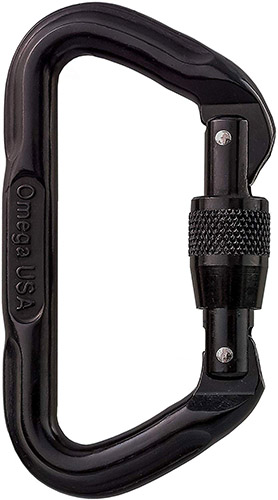
Made in the USA, the Omega Pacific Carabiner is one piece of climbing gear which comes with a simple design and yet, very effective. It is perhaps one of the best locking models you will find there as it has been designed for high performance and strength. It comes in a D-shape and affords you a balance of strength and weight.
It has been certified per CE and ISO, has been proof load tested to half a hundred percent (50%) as per strength; thus, you can depend on it to be up to task. It comes in a camo color with its Gate Opening being 16 millimeters long and at seventy-four (74) grams weight. The Omega Pacific is always rope ready and features a True Radii which comes with no flat spots on the arcs and surfaces that bear ropes.
The Omega was built through a superior cold-forging mechanism with aircraft aluminum alloy which allows it to be very strong and durable for even the hardest climbing scenarios. So, as you manipulate your respect for the law of gravity on rock slopes, you can carry on with a solid rest of mind. It is well ideal of use by rescuers, arborists, in the industry, and for safety bound cases.
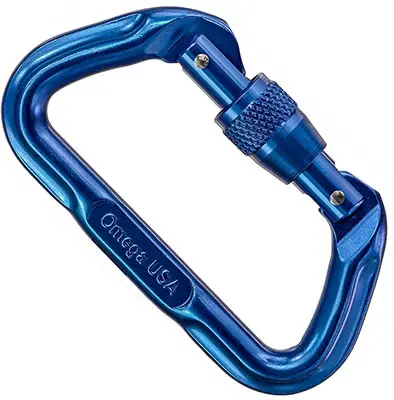 |
Pros
Cons
|
2. GM Climbing Twist Locking Carabiner D Shape
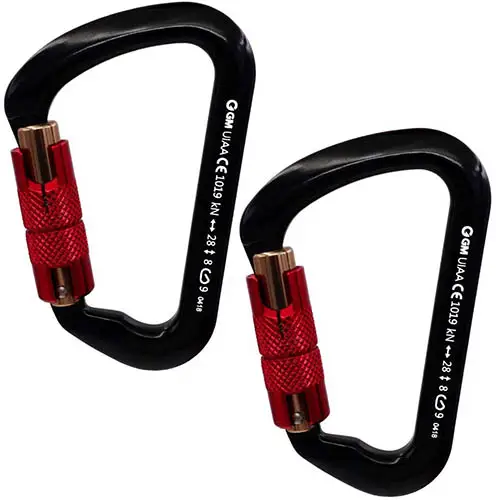
If you are the hard rock climber who does not get tired of hitting the mountain slopes, you have found your right companion with the GM Climbing 28kN carabiner. It is D shaped and comes with a rating of 28kN/6295lbf and is certified by CE and UIAA.
The offset D shape in which this carabiner comes in enables it to prevent loading around the gate side. It does this by shifting to the spine hence making it safer and stronger. Also, the style of the key lock has been carefully built to eliminate the possibility of bolt, rope, or gear snagging.
The GM Climbing comes with a rounded construction and this makes it to be a great choice for the ropes to smoothly pull or run when climbing. The ergonomics of the carabiner is spot on as it has improved for better handling.
One other big feature of the GM us its wide gate opening as it allows for seamless clipping when climbing. With the wide gate opening also comes a wide inner space which allows for easy multipoint linkage of the ropes. Its anti-crossloading construction features a groove around the lower part of the carabiner which holds the webbing or rope and ensures they do not slide up. This way, it significantly reduces the tendencies for crossloading to occur.
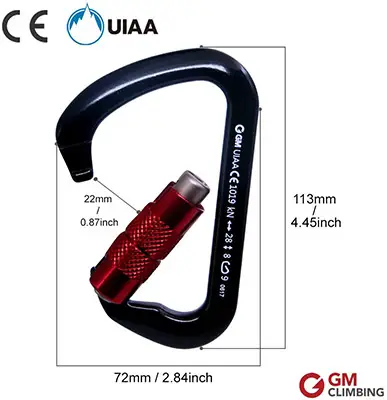 |
Pros
Cons
|
Non-Locking Carabiners
3. Hook It Clips – Rubber Coated Stainless Steel Caribiner
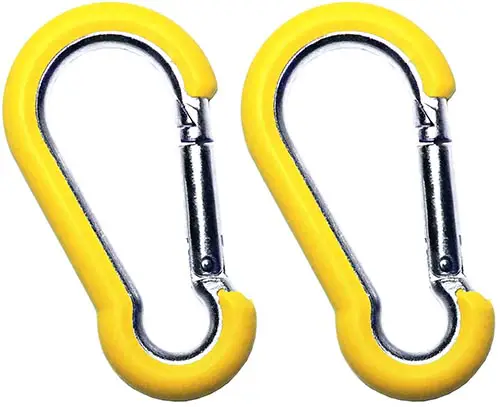
Designed by the Hook It company, the Hook It Clips Carabiner is a good choice when it comes to non-locking carabiner. It has been carefully engineered to stay operative without losing its functionality to rust.
If you enjoy working especially in wet regions, this carabiner will be a great choice as it has been coated with rubber so as to prevent rust or peeling away.
The carabiner is very versatile and ideal for varying usage purposes. It is great for marine, recreational boats, rigging, fishing, camping, as well as in car repairing and construction purposes. With its rubber coating, it will not leave any scratch on your boat or vehicle no matter how frequent and hard you use it.
It is built with 316 stainless steel and this lends to its impressive strength and durability. It can hold a weight up to 650lbs without breaking. It comes in 8 variant colors which works equally to shield from ultraviolet radiation.
However, the carabiner is not made for overhead usage such as towing or rock climbing.
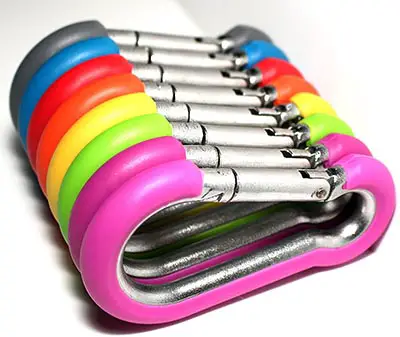 |
Pros
Cons
|
4. Element Equipment Tech Lite Carabiner
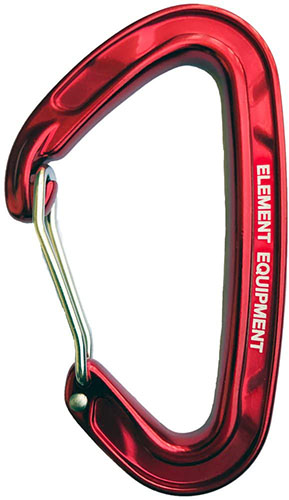
The Element Equipment Tech Lite Carabiner is one of the newest models from the Element Equipment company. It offers a combination of performance with sleek design.
It is very lightweight at 34 grams and you wouldn’t find it difficult to operate. While it looks a lot sleek and simple in its design, it delivers almost the same level of utility as other high-end non-locking carabiners. It is built of 7075 Aluminum which speaks a lot about its durability.
The Element Equipment Tech Carabiner is a great choice for backpackers and climbers alike. It would work well and will fit perfectly for rigging too. It comes with a major axis rating of 225kN, minor axis rating of 8kN, and a Gate Open rating of 8kN. There is a hood nose on the carabiner which helps to prevent snagging, also a very smooth wire gate action.
You will find it interesting to use if you are trying to hang aerial silks, or trying to drive in an anchor. Also ideal in situations where you need to upgrade a hammock tree buckle suspension.
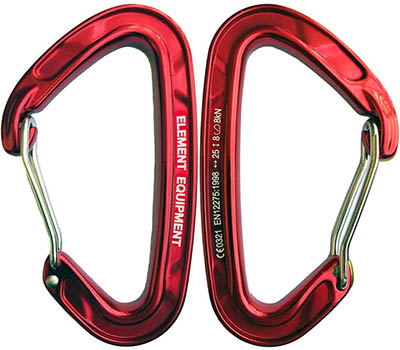 |
Pros
Cons
|
Quickdraws
5. Kailas Vacuo Quickdraw Set Carabiner Pack
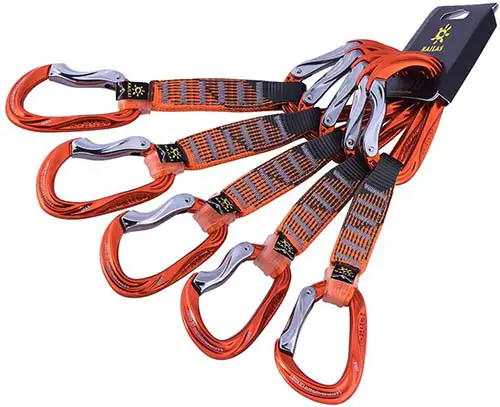
You got a thing for quickdraws? This one will set your climbing passion on fire! For your next climbing adventure, the Kailas Vacuo Quickdraw will be a great fit to take your skills a lot further towards perfection.
The Kailas Vacuo quickdraw is heavy duty, designed for frequent rock-climbing usages. It has been CE0082 EN12275 certified. It was hot-forged with the 7075-aluminum alloy and this greatly increases its strength. It comes with larger rope touch surface which improves the running of ropes hence ensuring wear reduction.
Unlike some other carabiners, the Kailas is designed with a no-hook type of nose keylock which paves way for seamless attaching and unclipping. With this feature, it also removes snagging risks on hangers or ropes. It delivers a 22kN amount of strength. The ergonomics of this carabiner is stunning as it allows for proper and comfortable handling.
In addition, it features a 26 millimeters width grade bandlet with rubber sleeve located at the tip of the gate so as to avoid rotation.
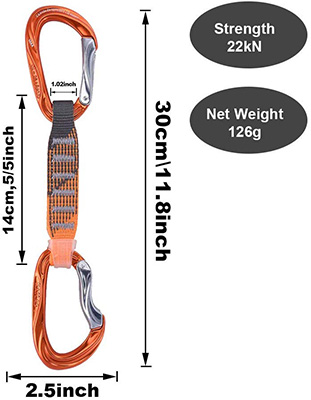 |
Pros
Cons
|
6. Fusion Climb 4-Pack 12cm Tactical Military Rescue Quickdraw
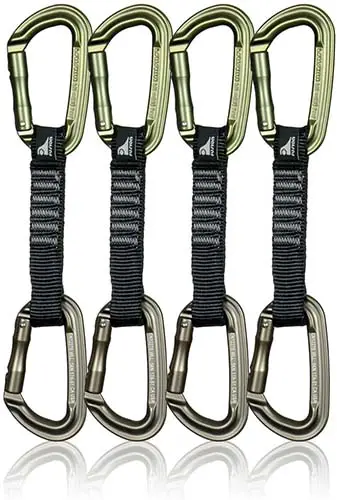
The Fusion Climb Rescue Quickdraw is recognized to be one of the best quickdraws which serves well when it comes to security and superior functionality. You almost cannot have enough of it. It is a four-piece set of quickdraws that have been CE UIAA certified as it meets with industry requirements for durability and safety.
It is very lightweight, being made of ultralight aluminum alloy construction and this is why it is such a strong piece of gear. It is designed for better ergonomics around its body so you can easily hold firmly. The color design is very low-key so it can be suitable for tactical usage purposes.
The rope contact surfaces are designed with smooth texture and sufficiently wide so that the ropes can pull or run smoothly without overlapping and wearing on each other. It works well when clipping and its anti-crossload system makes it all the more perfect for rock climbing.
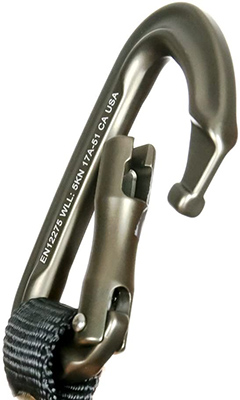 |
Pros
Cons
|
Conclusion
Whether you are up for climbing the rocks or you are just trying to get through your fishing activity, these carabiners are always rope ready and up to task. We have tested and found them to be of all-round great performance in their respective categories and with any of them, your climbing experience has never been better!
You may also like:


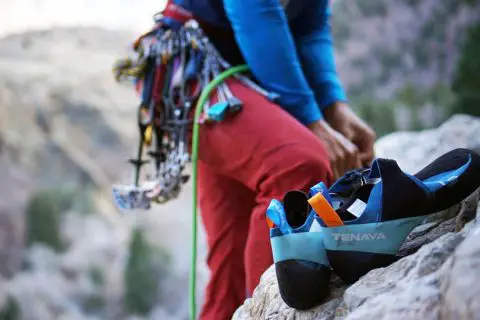
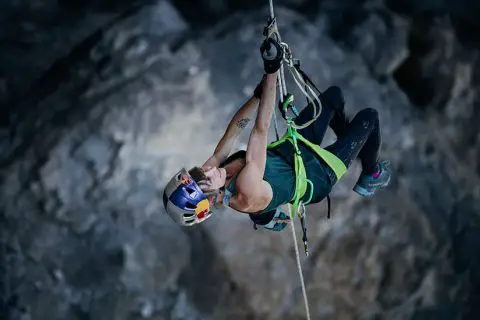
One comment
Comments are closed.